Riding the flat and running walk on a Walking Horse is like floating through air—it’s the ultimate ride,” says performance horse trainer Wendy Said, who has trained pleasure (flat shod) Tennessee Walking Horses, among other breeds, in Southern California for more than 25 years.
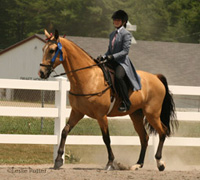 The Tennessee Walking Horse derived from the Narragansett Pacer and the Canadian Pacer, unique for their pacing gait, which was smoother than a trot. Often Walking Horses fall into this two-beat pace, where feet on either side rise together rather than a flat or running walk. “At a walk, your horse should have a loose four-beat footfall, with each foot hitting the ground individually,” Wendy explains. “Your goal is to continue this footfall while moving up to your faster gaits [flat walk and running walk].”
The Tennessee Walking Horse derived from the Narragansett Pacer and the Canadian Pacer, unique for their pacing gait, which was smoother than a trot. Often Walking Horses fall into this two-beat pace, where feet on either side rise together rather than a flat or running walk. “At a walk, your horse should have a loose four-beat footfall, with each foot hitting the ground individually,” Wendy explains. “Your goal is to continue this footfall while moving up to your faster gaits [flat walk and running walk].”Wendy applies traditional training techniques to help her Walking Horses achieve these comfortable, ground covering gaits. Whether you show your Tennessee Walker or want to enjoy a smoother ride on trail, practicing these training techniques and learning some basic maneuvers can help you achieve those sought-after gaits.
The Basics
Sometimes, all a Tennessee Walking Horse needs to snap out of the pace and move into a flat walk is for his rider to use a few half-halts and drive him forward into the bit. “A half-halt is a maneuver where the rider engages forward movement with his or her legs while softly checking or slowing the horse’s front end through the reins. This allows the impulsion of the horse’s movement to be collected up to the rider’s aids [hands and legs]—creating roundness and balance,” Wendy says. “The half-halt is just a brief moment in time. The horse’s hind end will keep moving forward while his front end momentarily pauses.”
But with some Walking Horses, achieving the proper gaits is not so simple. Rather than using harsher bits or gadgets, Wendy relies on basic training principles. “Your goal is to create a supple horse that knows how to use his individual body parts and how to give to the rider’s leg. These are the same principles applied in basic dressage and most other disciplines,” Wendy says. Like all horses, your Tennessee Walker will benefit from becoming supple. Even if your Walking Horse gaits smoothly rather than paces, or if he gets “trotty” when you move him up, he’ll benefit from suppling. Wendy puts a strong emphasis on bending exercises and prefers to start horses in a hollow mouth snaffle; however, any bit your horse works comfortably in should be fine for these exercises.
Where to Start
Whether retraining a horse or starting a youngster, it all begins at the same place. Start at the walk and work on bending—circles, serpentines, figure eights and more. When you bend your horse, it’s important to use your inside leg to your outside hand and not let him drop his shoulder in. Tip your horse’s nose to the inside, far enough so that you can see his inside eye and so that he really bends. “The reason this is so important for a Walking Horse is that it teaches him to dramatically step underneath himself and position his hind end—creating an arch,” Wendy says.
Turns on the forehand are also emphasized in Wendy’s program. “This maneuver is a continuous sequence of steps. The forelegs are keeping time while the hind legs are making a quarter or half circle around them, one hind leg crossing over the other. Turns on the forehand help to supple the horse and prepare you both for the next step of your training.” Wendy recommends setting up cones for a visual aid. Start with four cones. Place your cones in a large square in the middle of your arena. Walk your horse around the outside of the square. “As you approach the first cone and half-halt, turn your horse’s nose toward the cone with your inside hand [hand nearest the cone]. Slide your inside leg behind the girth, pushing your horse’s hind end a quarter of a turn. Your outside leg and hand give slightly but support the shoulder from moving out sideways,” Wendy explains. Once you have mastered a quarter turn, reduce your cones to two, increasing the maneuver to a half turn. If your horse is prone to pacing, it’s important to practice turns on the forehand before moving on to the next exercise so that your horse understands how to move his hip away from your leg.
The Gait
After your horse is supple and moves easily off your leg, move him up to the flat walk. To advance the gait, maintain light contact on the bridle while pushing your horse forward with your legs. “If your horse has a four-beat rhythm, you’re good to go,” Wendy says. If he instead begins to pace, your suppling practice will come in handy. Wendy uses the following exercise to disrupt a pacing horse’s footfall:
As your horse is pacing along, half-halt him. Next, tip his nose toward the rail at a 45-degree angle while you use your outside leg just behind the girth to push his hips to the inside (your inside leg and hand will support his shoulder and keep it from dropping in). Thus, his front feet and hind feet will be moving on two different tracks or paths: front feet on the outside track and hind feet on the inside track. In this position, it will be hard for your horse to continue to pace. By pushing his outside hind leg in, you can disrupt the pacing footfall and start the correct four-beat rhythm.
If your horse begins to flat walk, rechannel him straight and continue forward: a quick reward for a job well done. Unfortunately, some horses don’t easily break the pacing habit, and for them you’ll have to keep trying. “The idea is not to go sideways down the rail but to disrupt the incorrect footfall and alter his next step. If your horse is still pacing after 10 feet, bring him back down to the regular or ‘dog’ walk and try again,” Wendy says.
Also watch out for frustration. If you or your horse become frustrated, no learning will take place, so take a break from the exercise.
Although this maneuver will not work for all horses, Wendy’s found it very useful for even the most hardened pacers. If your horse is not responding to your leg, go back to circles and turns on the forehand. It may take a while to find success, but remember you’re teaching the horse a life skill. Once he understands and responds to what you’re asking, keep practicing to refine the skill. Eventually a slight tip of his nose followed by leg contact behind the girth will become a cue to gait whether you’re in the ring or out on trail.
Micaela Myers is a horse-owner and freelance writer based in California.
This article originally appeared in the May 2004 issue of Horse Illustrated. Click here to subscribe.

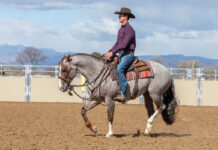
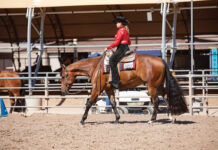
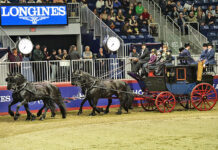
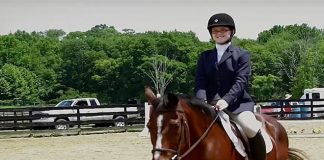

I have had several horses that did a nice, natural, 4 beat running walk and it is a joy to ride. The one I am riding now is a hard pacer and although her flat walk really covers ground, that second speed is bone jarring. We work and work for improvement.
Thanks for having this article available for people to see and print! It sure saved my neck when I couldn’t find any other “Reliable” source for Saddle Seat riding! Thanks again! From, Uma
Great Article!
i don’t like the idea of turning your horse’s head to ask him to gait, it seems stupid
I like western riding much better. I tried English riding, but it is sorta stuck up and wasn’t as much fun as barrel and pole racing.
very great article! it has helped me a lot!
i’ve used these methods to keep my TWH in gait…when he gets lazy he sometimes falls into a trot instead of a flatwalk. great advice!!
This is great! I’ve tried suppling my TWH mare and she is a lot more eager to do a Running Walk now. This winter all she did was pace or trot, but thanks to this article I’ve been able to help her into her natural gait. Thanks!
I have a 12 yr old TWH who started pacing after a ride with some Qtr horses. Have been told he is conformation wise a frontward horse with little bend which is why he can tolerate the round pen for about 25 minutes. So when you say I need to supple him with bending I am at a loss. Can you help? Some other exercise to help with this pace?
I just found out my paint is a spotted saddle horse, and he has a wonderful running walk!
Good article
Thanks
This seems really handy and useful! I’ll give some of this a try with my Tennessee Walker, she’s 7 and as far as I know hasn’t been trained to do her other gaits so my riding coach and I have been trying to get her to pick the Running Walk up by walking her fast but not allowing her to trot. I’ll maybe work on suppling her and then keep trying.